Bain Classic | Report

Introduction: The world of capital turned upside down
Global capital markets have been in a state of turmoil since the financial collapse in late 2008. Ongoing intervention by fiscal policy makers and central banks to stimulate growth since then has heavily impacted equity and bond markets and depressed benchmark interest rates in many markets to historic lows. The turbulence has left senior corporate executives, institutional investors and financial intermediaries looking to allocate capital in a quandary: After the crisis has passed, will familiar capital market conditions once again reassert themselves? Or will markets settle into a new pattern that will require major shifts in investor behavior?
To tackle that question, Bain & Company’s Macro Trends Group set out to understand how underlying capital trends will influence the longer-term global investment environment by investigating how the quantity and scale of assets on the world balance sheet have evolved over time. We discovered that the relationship between the financial economy and the underlying real economy has reached a decisive turning point. The rate of growth of world output of goods and services has seen an extended slowdown over recent decades, while the volume of global financial assets has expanded at a rapid pace. By 2010, global capital had swollen to some $600 trillion, tripling over the past two decades. Today, total financial assets are nearly 10 times the value of the global output of all goods and services. (For a description of the relationship between financial assets broadly defined and the real economy, see below, “What do we mean by ‘capital’?”)

Macro Trends Insights
Demographics, automation and inequality could dramatically reshape our world in the 2020s and beyond. Our insights discuss how executives can prepare for the new global economy.
Our analysis leads us to conclude that for the balance of the decade, markets will generally continue to grapple with an environment of capital superabundance. Even with moderating financial growth in developed markets, the fundamental forces that inflated the global balance sheet since the 1980s—financial innovation, high-speed computing and reliance on leverage—are still in place. Moreover, as financial markets in China, India and other emerging economies continue to develop their own financial sectors, total global capital will expand by half again, to an estimated $900 trillion by 2020 (measured in prevailing 2010 prices and exchange rates). More than any other factor on the horizon, the self-generating momentum for capital to expand—and the sheer size the financial sector has attained—will influence the shape and tempo of global economic growth going forward.
What does a world that is structurally awash in capital look like—and what will it mean for businesses and investors? The most immediate effect has been to paralyze, confuse and distort investment decisions. Large financial flows are creating dangerous pockets of excess capital in some places, while simultaneously cutting off access in other places where risk premiums are prohibitively high. To navigate the shifting currents of global growth in a time of capital superabundance will require financial market participants to recalibrate their expectations, acquire new skills for spotting and managing risk, and exercise enormous investment discipline. As we will elaborate in the following pages of this report, successful corporate and financial investors will be challenged to adapt to five new imperatives.
- Rethink hurdle rates. A prolonged period of capital surplus will be characterized by persistently low interest rates, high volatility and thin real rates of return. Some big institutional investors, like pension funds, will face large gaps between the returns they will need to meet payouts to beneficiaries and what markets will generate. To get into sync with these new conditions, all investors will need to ratchet down their market interest rate expectations and revise their internal investment hurdle rates and portfolio investment return targets accordingly. Without these adjustments, they may end up keeping their capital on the sidelines indefinitely while waiting for higher-return opportunities that will not materialize.
- Prepare for bubble risks. Capital superabundance will increase the frequency, intensity, size and longevity of asset bubbles. The propensity for bubbles to form will be magnified as yield-hungry investors race to pour capital into assets that show the potential to generate superior returns. Because the global financial system has grown so large relative to the underlying economy, asset values can quickly reach unsustainable levels and remain inflated for months or years, tempting businesses to commit resources in pursuit of unachievable returns. Already, we see that steeper risk premiums have effectively cut off some borrowers from access to credit despite an environment of all-time low interest rates for risk-free benchmark assets. Investors, businesses and even entire economies that are closely linked to commodities, which straddle the real and the financial economy, will be especially exposed to heightened bubble risk. The ever-present danger of asset inflation will contribute to an overall steepening of the investment risk curve, which will influence the shape of capital markets through 2020. To defend themselves, companies will need to strengthen their bubble-detection capabilities by building on insights derived from the long-term fundamentals of their businesses. Banks, hedge funds and other financial intermediaries that enhance their risk-pricing skills will be better positioned to generate above-market returns over the longer term, earning them a competitive edge.
- Actively manage the balance sheet. Capital superabundance will require even the most traditionally stable businesses to operate in much the same way as many hedge funds do, by actively managing their mix of long and short positions to insulate themselves against a more volatile macroeconomic environment across their portfolio of business activities. For nonfinancial businesses, in particular, an extended period of abundant capital will change the balance sheet from an object of thrift, to be managed to minimum size, into an important strategic platform with defensive and offensive potential. Leading companies will actively use the balance sheet, using cash and financial instruments, among other tools, to stabilize and enhance their core business strategy.
- Open investment channels to emerging markets. The capital needs of the faster-growing emerging markets would appear to make them a natural destination for the large stock of financial assets that remain concentrated mostly in the advanced economies. In an ideal world, capital would flow toward the best growth opportunities based on risk-adjusted returns; and indeed, capital has been migrating toward developing nations over the past several years. But the movement of funds from the US dollar, euro and yen markets to the capital-scarce emerging economies around the world has not been as strong as might be expected given the large growth differentials. Emerging markets’ financial systems often lack liquidity, depth and breadth, and they need to develop the “trust architecture” of workforce talent, regulatory consistency and flexibility, and political stability to attract and distribute the flow of capital on a global scale. Those bottlenecks may gradually ease over the course of the decade, presenting attractive prospects for the financial services industry and enabling global investors to penetrate deeper into more emerging markets. Financial firms headquartered in the emerging markets are especially well positioned to play a leading role by tapping their own institutional connections and trusted networks to facilitate capital flows.
- Look to the far horizon. Capital superabundance will tip the balance of power from owners of capital to owners and creators of good ideas—wherever they can be found. But as yield-seeking capital increasingly crowds into all available asset classes, diversification will become even harder to achieve. Indeed, over the past decade the returns among assets that have traditionally been negatively correlated—equity values moving up as bond yields decline, for example—have begun to move in the same direction. Over the coming years, both financial and strategic investors will need to extend their time horizons in order to find diversification and solid returns. Many of the most attractive growth opportunities we see across this decade will require patient capital—in healthcare to accommodate an aging global population, infrastructure development and renewal in developing and advanced markets, frontier technologies like robotics and genomic science, as well as others that Bain identified in “The Great Eight: Trillion-Dollar Growth Trends to 2020,” our 2011 macro trends report. Investors who re-peg their hurdle rates in line with decade-long low interest rates will find that betting on the far horizon is uniquely well suited for this period of capital superabundance.
1. The growing challenge: Too much capital
The expansion of the financial sector has accounted for an increasing share of world economic growth for years. The shift began with the end of the Bretton Woods system in the early 1970s and has accelerated since the 1980s with the advent of financial engineering, computing power and regulatory changes that reinforced it. The steady, decades-long buildup of financial capital has masked the fact that real economic growth was slowing.
The consequences are plain to see: Economic recovery remains stalled while households and banks in the US and EU shed debt and rebuild their balance sheets; regulators impose strict new capital requirements and mandates on the banking sector; and governments, particularly on the periphery of the euro zone, struggle to restructure high loads of public and private sector debt. Accompanied by macroeconomic volatility and interventionist central bank policies, these painful adjustments have clouded the near-term outlook for capital markets.
Looking beyond today’s market conditions, however, our analysis found that capital superabundance will continue to exert a dominant influence on investment patterns for years to come. Bain projects that the volume of total financial assets will rise by some 50%, from $600 trillion in 2010 to $900 trillion by 2020 (all figures are in US dollars at the 2010 price level and market foreign exchange rates), even as the world economy increases by $27 trillion over the same period (see Figure 1.1).
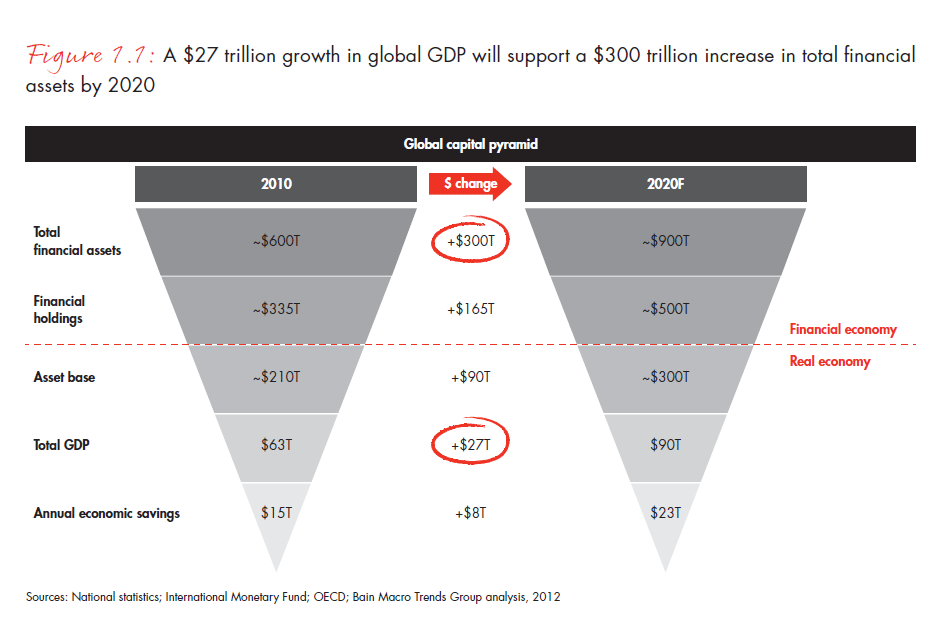
As it has for more than the past two decades, the large volume of global financial assets will continue to sit on a small base of global GDP (totaling $90 trillion by 2020 versus $63 trillion in 2010). At that level, total capital will remain 10 times larger than the total global output of goods and services—just as it is today—and three times bigger than the base of nonfinancial assets that help to generate that expanded world GDP.
The most notable change affecting global financial assets will be the composition of their sources (see Figure 1.2). Increased real economic activity in the US and EU, albeit at a slow pace, will continue to add to business and household wealth. Adding the leverage provided by financial intermediaries, financial assets in the advanced economies will grow by some $170 trillion. By far, the more rapid rate of expansion in financial assets will take place in the emerging markets (see Figure 1.3). Our analysis projects that capital sourced in these nations will account for more than 40% of the global increase, or $130 trillion, through 2020. (Again, all figures are in US dollars at the 2010 price level and market foreign exchange rates.) Growing at a 9% compounded annual rate, the proportion of capital sourced from emerging markets will increase from less than one-tenth of the global total, or just $20 trillion, in 1990 to about one-quarter, or nearly $220 trillion, by the end of the decade. (See below, “China will generate more capital than it absorbs”.)
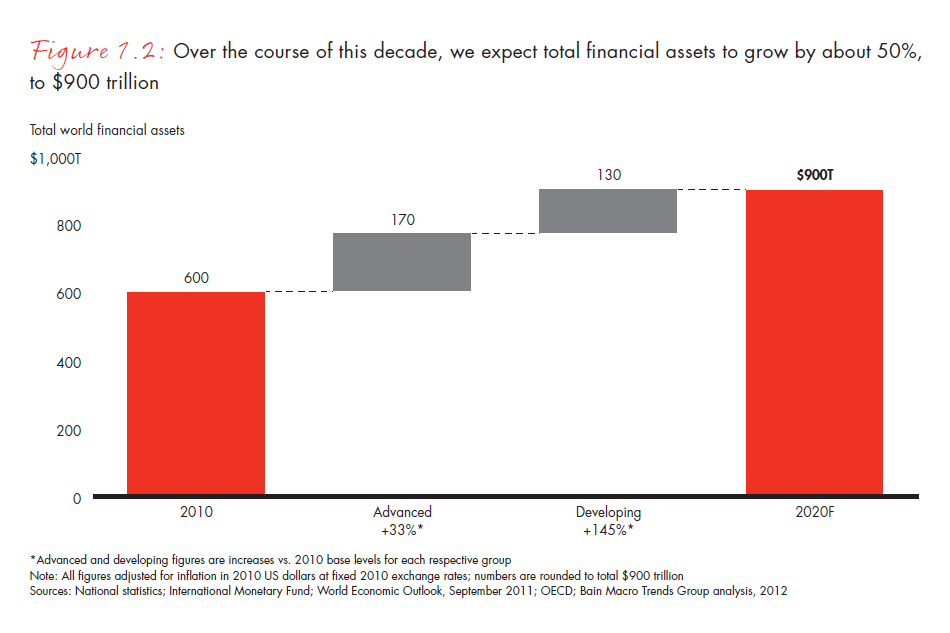
Financial capital will continue to be one of the most powerful forces influencing global economic activity—and business and investor behavior—for the foreseeable future. As we will describe, its effects will be felt on interest rates, asset prices and real returns on investments. Corporate leaders who grasp the implications of long-term capital superabundance and learn how to navigate its powerful currents will be better able to spot solid investment opportunities that will help grow their businesses.
2. New risks: Chasing yields but catching bubbles
In good economic times and bad, the overarching objective for owners and managers of capital is to seek out the best possible risk-adjusted rate of return on the money they invest. That essential role for capital in a market economy powers a virtuous cycle: Money invested in tangible assets and research expands productive capacity, increases GDP and generates profits that can be plowed back into fueling further economic growth. In a world saturated with financial assets, however, that classic pattern of wealth creation is causing disturbances that will give rise to new risks.
Facing capital superabundance, investors are straining to find a sufficient supply of attractive productive assets to absorb it all. The sheer volume of liquidity being pumped into the markets by major central banks has sparked inflation fears. Stockpiled with financial assets, yield-hungry investors are venturing well beyond sustainable income-producing investments in pursuit of returns that for many could prove illusory. Given the ample spare capacity for production across the world, however, we expect that inflation will not show up in core prices in most markets but rather in asset bubbles, which have moved from being relatively isolated events to system-shaking crises claiming trillions of dollars in losses (see Figure 2.1).
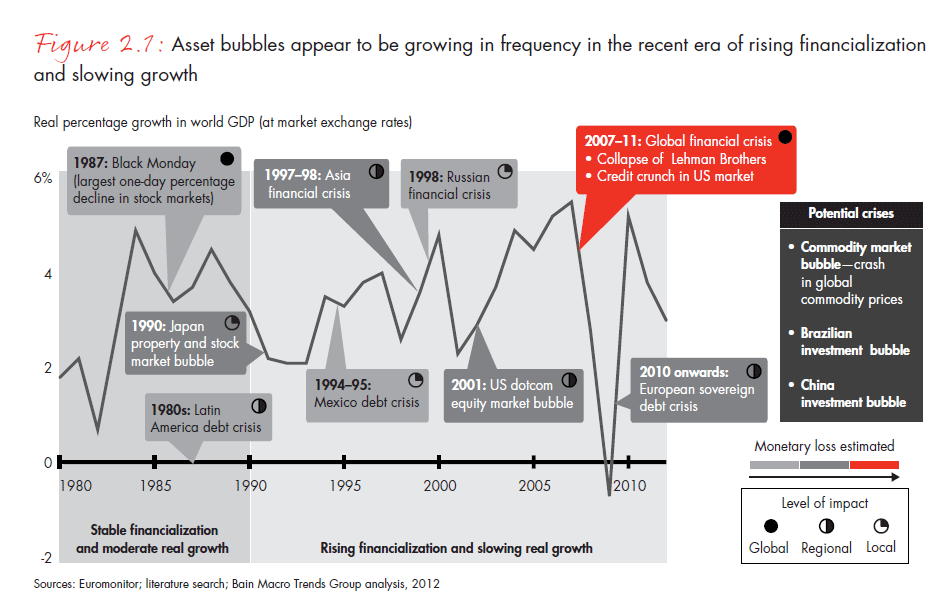
Look for bubbles to remain a disruptive fixture of the low interest rate global economy through the balance of the decade, as investors move quickly when price signals indicate that an asset is primed to appreciate and pump in capital that further drives up its price. Asset bubbles will percolate most commonly in commodities—from basic raw materials and agricultural products to precious metals and rare earths—when unforeseen production bottlenecks or adverse weather quickly mobilize waves of investor interest that typically overshoot the supply–demand balance. Commodities are especially prone to bubble risk because investors see them as ways to participate in the more rapid growth of emerging economies while keeping their capital in the liquid and regulated markets of the advanced economies. (For a discussion of why it remains difficult for investors in the advanced economies to find outlets for investment in the developing economies, see below, “Moving capital from North to South”.)
Over the coming years, the ease, speed and magnitude of global capital moving around world markets will make the knock-on effects of the bubbles it creates deeper and more disruptive. Bubbles are also apt to form in illiquid assets like real estate, industrial capital goods or transportation equipment. The plentiful availability of low-cost credit, securitization and other sophisticated tools of financial engineering have made it easier for corporate and institutional investors to trade in assets that have become more bubble prone.
In a capital-abundant world, investors will find it harder to steer clear of bubble risk. Until about a decade ago, it was fairly easy for corporate treasurers and investment advisers to hedge their exposure by constructing a balanced portfolio, using US Treasuries as a safe haven and diversifying their other equity, debt and commodity holdings. Over the past two decades, however, the benefits of diversification to limit risks have become harder to realize. Price movements across asset classes in both developed and emerging markets have become highly correlated, an indication that there are fewer reliable safe havens where investors can shelter (see Figure 2.2). For example, during the five-year period between 1990 and 1995, the variation in the price of 10-year Treasuries was negatively correlated with equity prices; between 2006 and 2011, the two assets had a nearly 30% positive correlation. On average, the correlation among all of the asset classes more than tripled across the two periods, according to an analysis by J.P. Morgan.
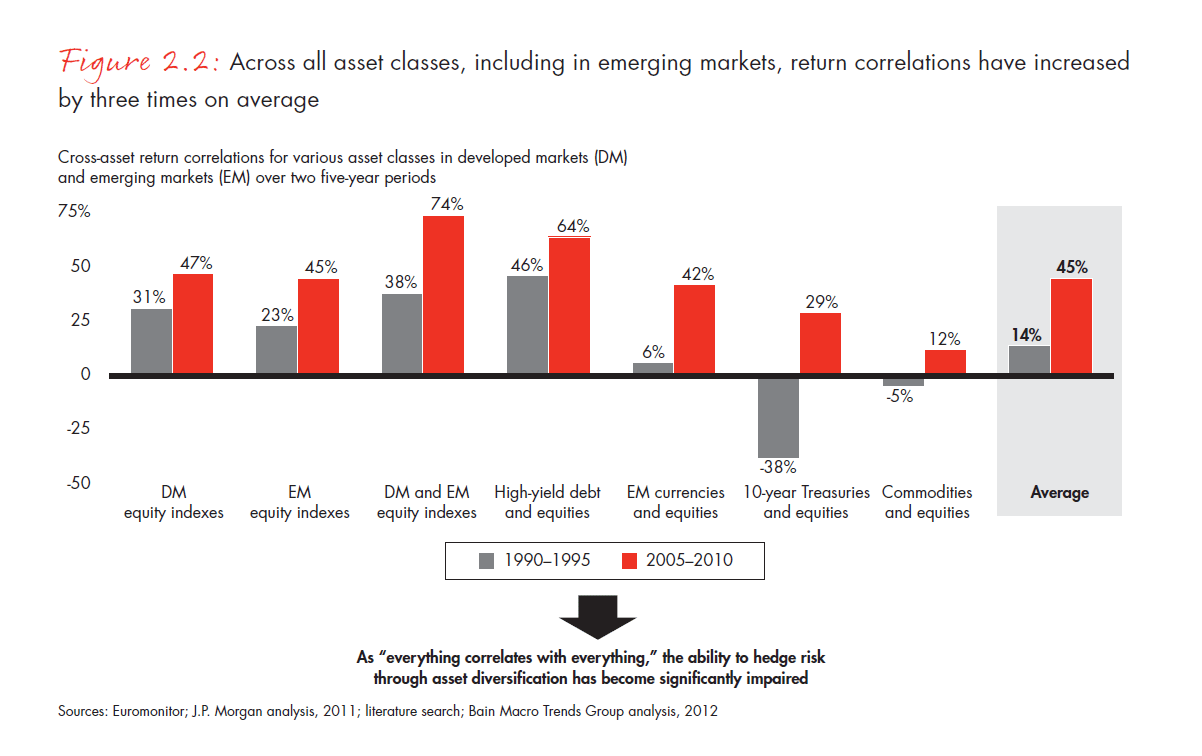
As we will see in the next section, businesses and financial intermediaries will need to sharpen their skills for identifying sound investment ideas and acting on them quickly. In today’s environment, the advantage has shifted decisively from having money to fund something to having something worth funding.
3. How to invest: Power will shift from owners of capital to owners of good ideas
For much of the past decade, global capital market investors have relied on the alchemy of financial engineering to boost returns. Well before the 2008 global credit market crash, the rate of growth of the world economy had been slowing. But even as returns on investments in real goods and services were declining, the trend was obscured by healthy-looking gains that professional money managers were able to generate through asset price inflation. Capital market turmoil and new regulatory mandates since 2008 have brought that pattern to an abrupt end.
Facing a prolonged period of capital superabundance, investors will encounter formidable challenges. With capital increasingly concentrated in the hands of professional investment managers, the competition for yield will be fierce. The sheer volume of mobile capital searching for elusive gains that outperform market benchmarks will continue to drive up asset prices in the readily accessible developed markets. Because it is more difficult for capital based in the mature economies to penetrate the emerging markets, investors attracted to those growth markets will be apt to overbid for the limited number of transparent investment opportunities available to them.
The investment supply–demand imbalance will shift power decisively from owners of capital to owners of good ideas. In this environment, investors’ success will be determined less by how much money they command than by their ability to spot an investment’s true value creation potential and act on it nimbly. For both nonfinancial corporations looking to expand and institutional investors seeking reliable returns in bubble-prone markets, today’s conditions call for fresh thinking about how and where to deploy capital and require new disciplines for managing the assets in their portfolios. (For a look at the growth themes that are likely to present the decade’s most attractive opportunities, see the Macro Trends Group’s 2011 report, “The Great Eight: Trillion-Dollar Growth Trends to 2020.”)
This change will not be easy. Reinforced by central banks’ unprecedented monetary easing, the plentiful supply of capital is holding interest rates at near-record lows and adding pressure on investors to find higher-yielding uses for their money. But the scramble for more promising ways to put capital to work, which is driving up asset prices, makes it difficult to identify investments that satisfy their risk-return requirements—the hurdle rate that the potential investment must clear to warrant committing capital in the first place.
By lowering their hurdle rate, investors can bring more potentially attractive investment targets into range. For companies that are unable to distinguish between those that have long-term potential to outperform and others that risk ending up as bubbles, however, a lower hurdle rate can add complexity and noise to investment decisions. Companies and investors that are able to filter out the volatility can take advantage of the sustained low interest rate environment to acquire new assets, penetrate new markets and cement long-term competitive advantages that will pay off for years to come.
In today’s capital-abundant times, the ability to identify owners of good ideas and help them achieve their full potential will be the hallmarks of investing success. Companies and investors that will thrive in this environment will be those that are best able to identify opportunities that play to their core competencies. They also will take care to develop a repeatable model that enables them to apply their organization’s unique strengths to new contexts again and again. Those that can react with speed and adaptability will be best able to identify the winners, steer clear of the bubbles and generate superior returns.
4. Where to invest: Paths to prosperity in a capital-superabundant world
Where will corporate strategists and financial investors find market-beating returns in the low interest rate, bubble-prone era of capital superabundance that now confronts them? Those who lift their sights from the short-term market signals to take in the broader sweep of the macroeconomic landscape that a capital-abundant world requires will discover big growth opportunities in two powerful forces that will shape the coming decade.
The first of these exploits capital’s inherent portability, that is, its ability to move around the globe to serve either domestic or foreign customers. Long a mainstay of investments in capital equipment and production capacity, the new opportunity for investors will be to tap the potential of capital portability in the ever-expanding and increasingly sophisticated services for export. A second promising path to buoyant growth will be taken by investors willing to reach for the “far horizon,” that is, for those big capital-intensive investments to build or refurbish badly needed infrastructure and the pioneering development of transformative technology platforms in nanotechnology, biotechnology, artificial intelligence and robotics, on which the biggest commercial breakthroughs of the twenty-first century will be built. As we will see, both areas are tailor-made for the volatile investment climate that will prevail through 2020.
Turning services into export-led growth
For decades, the expansion of the service sector has been the leading contributor to rising GDP in the advanced economies. Emerging markets are beginning to exhibit the same propensity toward services-led growth. As services displaced manufacturing in advanced economies, more of the economy’s value-creation capacity shifted to activities that were inherently not tradable—everything from real estate and personal care to restaurants and retailing.
As the sector matured over time, rates of return on these geographically bound services have grown slowly. Indeed, value added per employee in nontradable services has barely budged over the past two decades, growing at less than a 1% annual rate compounded since 1990 in the US. But globalization and the spread of powerful information and communications technologies have given rise to a vibrant, high value-added tradable services sector—in marketing, industrial design, investment banking and other business services, for example. Even as the advanced economies’ tradable capacity has decreased with the rise of the service sector overall, portable services make up a larger proportion of their output with export potential (see Figure 4.1). The faster-growing segment of the service sector over the past decade, portable services comprised between one-third and one-half of all services produced in the major OECD countries by 2010.
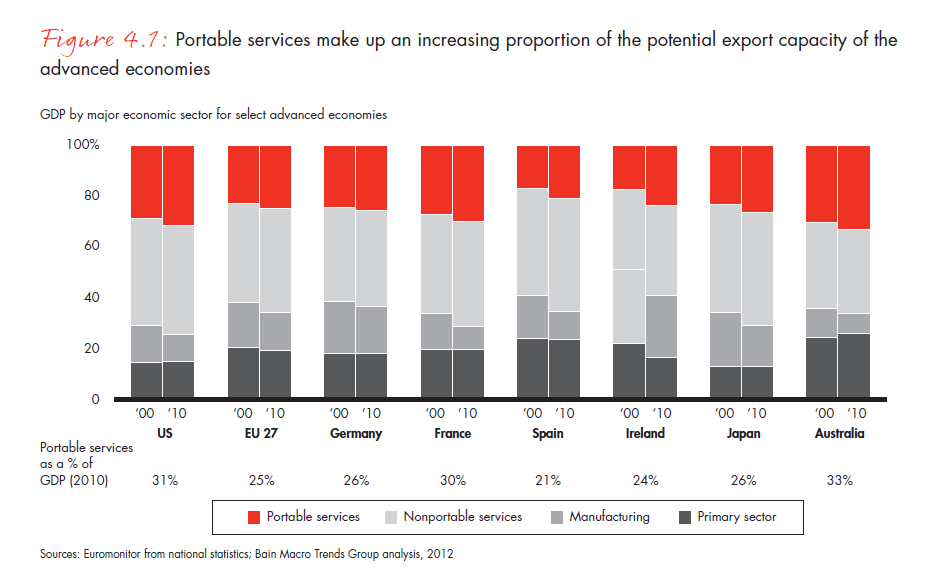
Taken together, the value added per US employee in the tradable services has grown at more than triple the rate of that in the nontradable services since 1990, to more than $125,000 in 2008, according to a recent study by the Council on Foreign Relations. Nations, industries and companies that find new ways to expand their tradable services stand to become magnets for investment and earn premium returns in the years ahead as global growth expands and diversifies. Figure 4.2 illustrates how big the potential contribution from tradable services to growth in the advanced economies can be, with deepening global economic interdependence.

Reflecting the strengthening of ties between the domestic and international economies, our analysis suggests that increasing gross exports will expand opportunities for the service sector to become more portable, which in turn will expand the economy’s export capacity. At a company level, the trend opens new avenues to profit from investments in services that are open to international trade.
The gains from converting nontradable services into tradable ones can be huge. The rate of return on services that are confined only to the local market is in the range of just 1% to 2%—in line with services’ productivity growth rate. Tradable services, by contrast, can yield returns that are many times higher. What makes these investments so compelling today is that they are channeled into activities the company knows best, thereby dodging the bubble risk that will plague investors that chase illusory returns in areas where they lack expertise.
Companies have only just begun to make services exportable, and technology will be a wind at their back as they ramp up its vast potential. Over the past decade, most of the focus in this area has been in business process outsourcing—using high-bandwidth telecommunications to move low value-added back office operations and call centers from high-cost developed markets to lower-wage emerging markets.
In coming years, more businesses will move beyond cost savings and seize opportunities to use exportable services to increase revenues and profits. A host of industries—from engineering and capital goods to healthcare, entertainment and energy—are potential beneficiaries of the trend as they diversify into value-added services. Exportable services, like design and marketing, will assume a bigger role in upgrading low-tech products into premium consumer goods and services. Over the next several years, the increasing availability of telepresence technologies will be a powerful enabler for making portable services that were once bound by physical geography. To meet some of the burgeoning demand for health services in developing economies, for example, physicians in the US or Europe will be able to treat patients around the globe.
The exportable services revolution will be a boon not just for companies in the developed markets, but for emerging market enterprises and economies as well. Portable services can help break through one of the biggest bottlenecks impeding development in the emerging markets—the shortage of management talent to enable them to sustain their rapid economic growth. By using distance-learning technologies to “export” higher education, leading universities in the advanced economies can accelerate the training of the home-grown specialists the emerging-market economies will need. And by “importing” the talent of engineers, managers, physicians and other highly skilled professionals from companies in developed markets, businesses in the emerging markets will not need to wait a generation before their own education systems can produce the skilled workforce they require.
Pursuing far-horizon investments
The decade-long span of low interest rates and abundant capital that lies ahead opens up a new set of long-term investment opportunities for corporate executives and financial investors. With the cost of capital at historic lows and looking to remain there, the discount rate that businesses apply to evaluate investment alternatives suddenly makes projects with a 20- or even 30-year time horizon commercially viable.
The significance of this shift is profound. For one thing, it brings into the range of the private sector large-scale capital commitments that only governments previously had the wherewithal to undertake. The ability of private investors to partner with the public sector will be a welcome development at a time when many governments are strapped with debt.
The pursuit of long-term investments will not only be something businesses will find possible to do; it will be the prudent thing to do. As we have seen, the vast sums of capital flooding virtually every asset class have stripped yield-hungry investors of their ability to diversify risk—a dangerous vulnerability during a period of market volatility such as we see now. The cross-correlation of risks in today’s bubble-prone, capital-abundant markets has obliterated the once-durable pillars of conventional diversification strategies. However, the diversification that investors cannot find by spreading risks across asset classes is available to them by staging their investments across longer time horizons. By doing so, they can be reasonably sure that they can bypass the bubbles and capture the long-term growth the global economy will surely generate.
The opportunities of far-horizon investing are attractive. Rather than settle for low returns in the volatile near term, investors and nonfinancial corporations that lower their hurdle rate and extend their time horizons can place surer bets on two broad investment themes that our analysis suggests will contribute at least $1 trillion each to global GDP growth by 2020. Critical investments to build or refurbish infrastructure in both the emerging and advanced economies will spur the need to form public-private partnerships. From the building of new water, energy and transportation systems to accommodate urbanization in the developing world to the modernization of obsolete highways, airports, railways, harbors and power grids in the developed markets, private sector engineering, construction and consulting firms will play a leading role (see Figure 4.3).

Investing in infrastructure projects should also hit the sweet spot for institutional investors, like pension funds, endowments, insurance firms, sovereign wealth funds and other owners of patient capital, that want to sidestep short-term market turmoil in favor of attractive long-term investments.
Far-horizon investing will enable technology companies and venture capital firms to look beyond the next hot project and take positions, instead, in breakthrough next-generation technology platforms that will emerge over the coming decade. From nanotechnology and artificial intelligence to genomics and robotics, game-changing technologies, which will spawn countless start-ups and alter how people live, work and play, are on the cusp of commercialization (see Figure 4.4). Applying the lower hurdle rates that the prevailing capital-abundant conditions require will enable companies and financial investors to build a portfolio of innovations that will produce tomorrow’s technology winners.
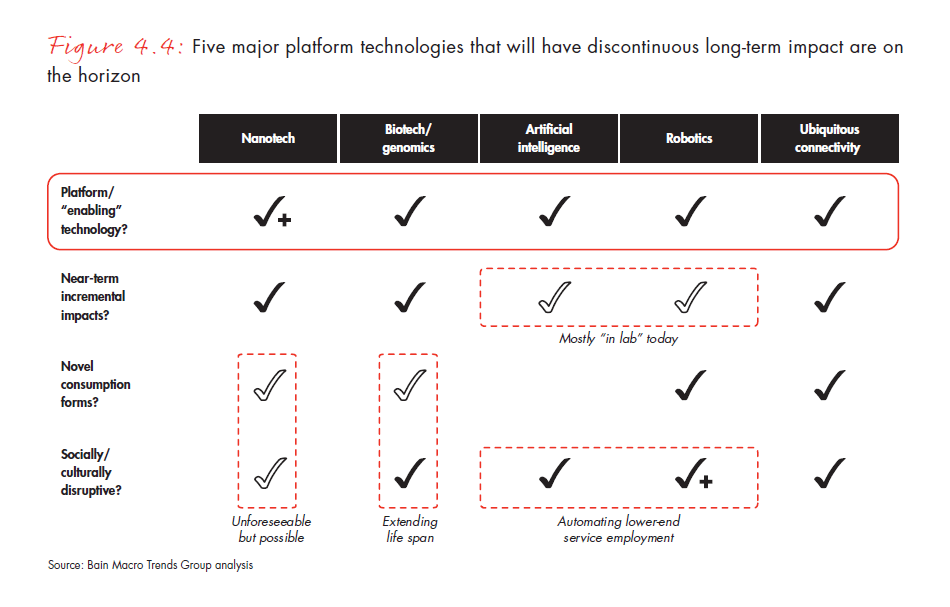
In order to benefit from the diversification potential of far-horizon investing, the financial markets will have to break through an unfamiliar bottleneck—the need to provide liquidity and flexibility in the here and now to those committing to investments that will return capital only years in the future. As attractive as it will be for nonfinancial companies to place long-term bets on promising opportunities, they will need working capital to fund current operations. That need could potentially be fulfilled by patient financial investors that lack technical expertise or operating capabilities but can identify the most promising long-term prospects and entrepreneurs. It will be up to banks, private equity funds and other investment intermediaries to engineer the next generation of novel— and trustworthy—financial products that help bridge investors’ different time horizon needs.
Having weathered the turmoil that financial engineering brought to the capital markets leading up to the subprime lending crash, investors will understandably be skeptical. The capital-abundant world that created this new challenge will be tested to come up with new solutions.
5. Implications: New tools for navigating in a time of capital superabundance
For businesses, investors and the financial intermediaries that serve them, life in a volatile time of capital superabundance has become immeasurably more complex. Unlike during the long period of relative macroeconomic calm that characterized the “great moderation,” they can no longer steer their companies or manage their portfolios guided by their corporate strategy alone. Facing the headwinds of tumultuous capital markets, low interest rates and a pervasive vulnerability to asset bubbles, they need a parallel macro strategy attuned to the broader new realities to help them chart their course through the challenging environment. Forces impacting them from far beyond their industries—surges of hot money that cause commodity prices to spike, disrupt supply chains or shrink profit pools—can easily overwhelm the most carefully drawn corporate or investment strategy. Tomorrow’s leaders are arming themselves with capabilities that will enable them to see beyond the capital market turmoil and deftly outmaneuver their competitors.
Businesses
Plan beyond lower investment hurdle rates. Because the cost of capital will remain low across the business cycle, access to capital will not be the limiting constraint on growth going forward. Low real interest rates change the calculation on all projects, including mergers and acquisitions and capital investments. Businesses will need to build lower interest rate assumptions into the computation of a new hurdle rate while carefully taking the risk premium into account. In addition to fine-tuning their project return analysis, companies with the ability to develop compelling intellectual property and attract and retain top professional, managerial and technical talent will best be able to overcome the biggest barriers to sustained profitable expansion through the balance of the decade.
Fine-tune your bubble-avoidance radar. With capital ready to be deployed in any promising-looking investment opportunity, businesses can easily allow themselves to be tempted by the false promise of higher yields. In the period ahead, expansion-oriented companies will deepen their understanding of the economics of their core business, know its sustainable rate of growth and be quick to spot red flags indicating when it risks exceeding its sustainable limits.
Turn your balance sheet into a strategic weapon. Whether they are planning to enter a new market, introduce a product line extension or pick up market share, successful companies will use their balance sheet to reinforce their strategic goals. Facing the same market volatility as their rivals, the leaders will anticipate how they can stabilize themselves against its risks and manage down the risk premiums they will have to pay to their investors. Wielding their balance sheet as a competitive weapon, companies (particularly those in industries exposed to big commodity price swings) will be able to use their cash reserves in combination with product development, pricing policies and other standard commercial tactics to outmaneuver their competitors. For example, options take on increased value in a highly volatile market and can be used to manage risks and create a decisive business advantage.
Investors
Learn to thrive in a lower risk-reward reality. Capital superabundance will bring down returns on investments in assets across every risk category, leaving investors with two unappealing choices: They can either ratchet down their expectations or move up the risk curve, pushing up asset prices in search of higher yields in a bubble-prone economy. Top-performing investors will learn to spot opportunities their less successful peers cannot see. Taking on additional risk will be lucrative for those that develop skills to price risk accurately. Those that cannot will risk getting burned.
Focus on the far horizon. As capital crowds into every asset class, investors lose both the benefits of diversification and the returns that come from a mix of safer and riskier assets. Those that take advantage of the low cost of capital to reduce their hurdle rate and stretch out their investment time horizons can recapture both. Angel investors and venture capitalists that have sharpened their skills for spotting promising longer-term investments should do well in the period ahead. Institutional investors will need to recalibrate their asset allocations to share in the rewards of far-horizon investing.
Add value to investments, not just cash. In a time of capital superabundance, portfolio investors will need to learn to do what the best corporate investors have always known: They will differentiate themselves by developing expertise and adviser networks that give them privileged access to investments where they can boost returns by fostering operational improvements that create growth.
Double down on due diligence. A critical skill for investors that face the risk of being crowded out of good investments is the ability to spot opportunities early, develop a proprietary investment thesis and test it thoroughly through a rigorous due diligence process. The leaders will be those that develop a sector expertise that enables them to gain early and unique access to undervalued assets.
Financial intermediaries
Strengthen your risk-pricing capabilities. Even as superabundant capital drives down interest rates overall, the averages will mask considerable variability in investment risks and returns. The yield curve will steepen dramatically across the spectrum of spread-sensitive investments from the prices of low-risk, triple-A-rated securities through those of speculative-grade bonds. Even within classes of similarly rated bonds, risks differ. For banks, insurance companies, hedge funds and other financial market makers, the ability to discriminate across and within risk categories, in combination with overall risk and capital management, will be critical for boosting investors’ returns.
Mind the shift from the banking system to the capital markets. Global financial institutions will need to expand their equity desks. Weak bank balance sheets and the risk of sovereign debt default have closed the traditional gap that made debt financing appear less risky and costly than issuing stock. The differences in risk-adjusted returns to debt and equity will blur, tilting the funding choices that companies and investors make in favor of equity or hybrid-equity financing—particularly in fast-growing developing markets or for far-horizon opportunities.
Deepen channels for capital to flow to emerging economies. The infrastructure for moving capital from the developed economies to the emerging ones needs a major upgrade. Governments in developing nations will need to implement financial and legal reforms that increase transparency and bolster offshore investors’ trust, of course. But financial intermediaries have a critical role to play—and an opportunity to profit by—forging regional alliances with trusted counterparties and creating more standardized products, like mutual funds and annuities, that enable global investors to safely move capital into and out of attractive investment targets in emerging markets under the shelter of a private trust architecture.
Develop products for far-horizon investors. Persistently low capital costs are bringing longer-term investment opportunities into play for both corporate and financial investors. But for those opportunities to bear fruit, banks and other financial intermediaries need to create a new range of products that enable investors to diversify the duration risks of investing over long time horizons while sheltering them from near-term macro volatility. Corporations will need liquidity that will permit them to fund ongoing operations, and institutional investors will want to construct laddered portfolios that smooth returns between the short and long term.
Capital takes many forms, from the cash flow generated by the economy’s output of goods and services and the capital equipment used to produce them to the accumulated wealth held as financial assets. As the inverted capital pyramid below describes, real economic activity is the engine that makes possible the accumulation and replenishment of capital assets. The economy’s productive capacity, in turn, spins off financial assets the owners of capital aim to invest in, creating new forms of wealth. When supplemented by leverage and creative financial engineering by banks and other financial intermediaries, the crown of the capital pyramid encompasses all financial assets.
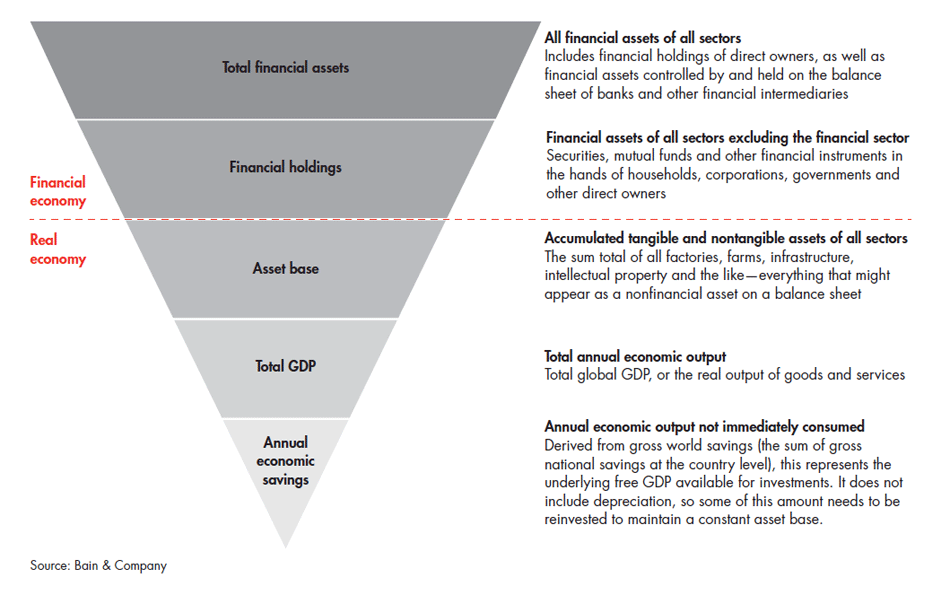
China will generate more capital than it absorbs
Since it embarked on its market opening reforms more than three decades ago, China has been a powerful magnet for global capital to finance its growth. Looking for Chinese GDP to resume its rapid expansion despite the current slowdown, many forecasters expect that pattern to persist for the foreseeable future.
Analysis by Bain & Company’s Macro Trends Group, however, shows China entering a major shift— from being a capital absorber to becoming an increasingly large contributor to the global financial capital supply. The capacity of the domestic Chinese economy to absorb capital productively is diminishing. The continued increase of fixed investments at historical levels is unsustainable, as marginal returns on capital are already diminishing. Foreign direct investment in China will decline as future growth prospects slow.
Meanwhile, China’s capital reserve balance—a dividend from the nation’s export-led growth—has expanded tenfold over the past decade to more than $2 trillion in 2010. Unsustainable over the long term, China is now transitioning from its policy of recycling current account earnings using low-yielding renminbi bonds that artificially depressed its currency exchange rate and further helped to fuel exports. As it pursues a more balanced approach to growth, Beijing has begun to permit China’s increasingly affluent savers to invest in a broader range of higher-return financial assets—including assets based beyond China’s borders.
How big will China’s capital footprint become? Based on International Monetary Fund data, we project that China will add $87 trillion (calculated at fixed 2010 exchange rates) to the growth of total global financial assets by 2020 (see figure). That is more than four times the amount of capital that will be generated by the Japanese economy and will surpass both the US and EU by some $25 trillion. From just $39 trillion in 2010, China’s contribution to the growth of global capital will increase at a 12% annual rate compounded to some $125 trillion through the balance of the decade, a threefold increase in its share.
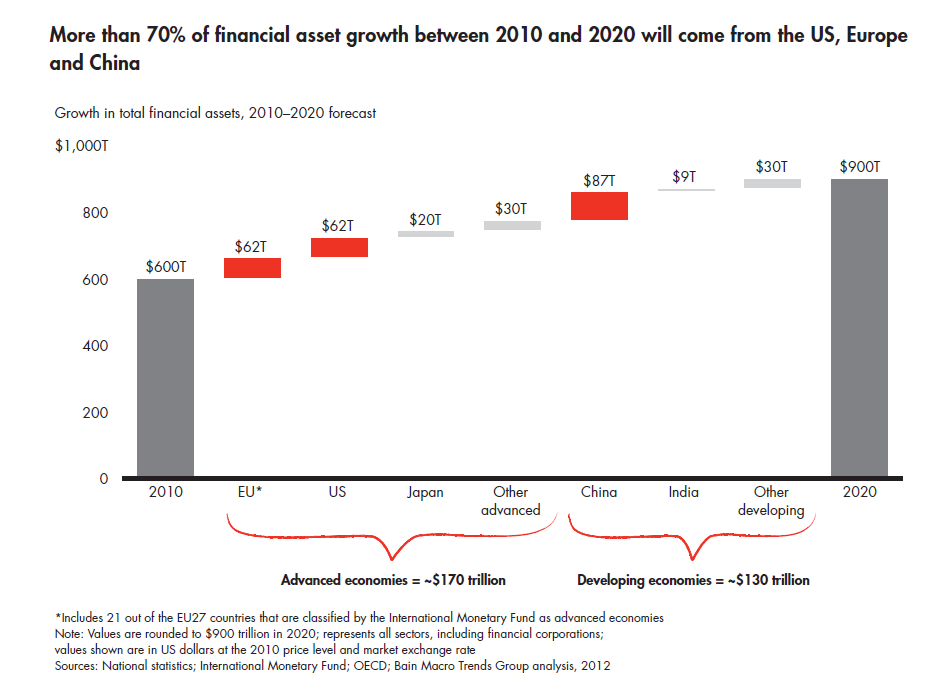
Moving capital from North to South: It’s hard to get there from here
A major contributor to the global economy’s propensity to generate bubbles is the geographic mismatch between where growth is taking place and where capital is concentrated (see figure). Despite strong growth in the developing markets, three-quarters of all global financial assets are pooled in the traditional financial centers of the advanced economies and will remain there through the end of the decade.
The narrow channels that keep capital bottled up in advanced markets magnify the bubble potential in both the advanced and developing economies. Too much capital ends up chasing too few growth opportunities in the advanced markets, driving up asset prices. When attractive investment opportunities do show up, they tend to command premium acquisition prices as investors pile in to snap them up.
As fluid as the movement of capital has become thanks to information technology and high-speed communications, the barriers that impede its flow to and among the capital-hungry developing markets will remain formidable. Investors will continue to favor the advanced markets, which are well endowed with the “trust architecture”—strong property rights protections, reliable legal systems and institutional depth—that owners of capital value.
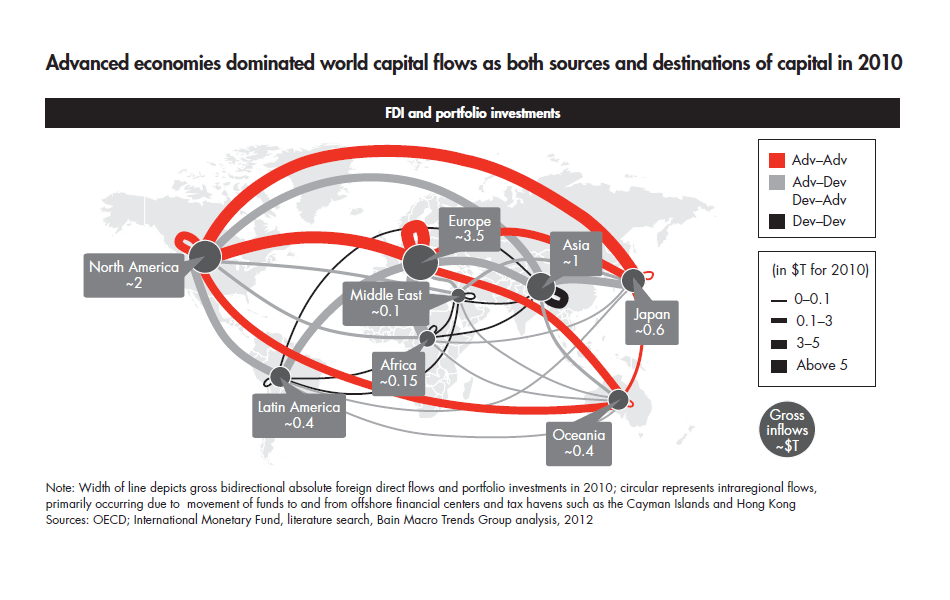
This work is based on secondary market research, analysis of financial information available or provided to Bain & Company and a range of interviews with industry participants. Bain & Company has not independently verified any such information provided or available to Bain and makes no representation or warranty, express or implied, that such information is accurate or complete. Projected market and financial information, analyses and conclusions contained herein are based on the information described above and on Bain & Company’s judgment, and should not be construed as definitive forecasts or guarantees of future performance or results. The information and analysis herein does not constitute advice of any kind, is not intended to be used for investment purposes, and neither Bain & Company nor any of its subsidiaries or their respective officers, directors, shareholders, employees or agents accept any responsibility or liability with respect to the use of or reliance on any information or analysis contained in this document. This work is copyright Bain & Company and may not be published, transmitted, broadcast, copied, reproduced or reprinted in whole or in part without the explicit written permission of Bain & Company. Copyright © 2012 Bain & Company, Inc. All rights reserved.